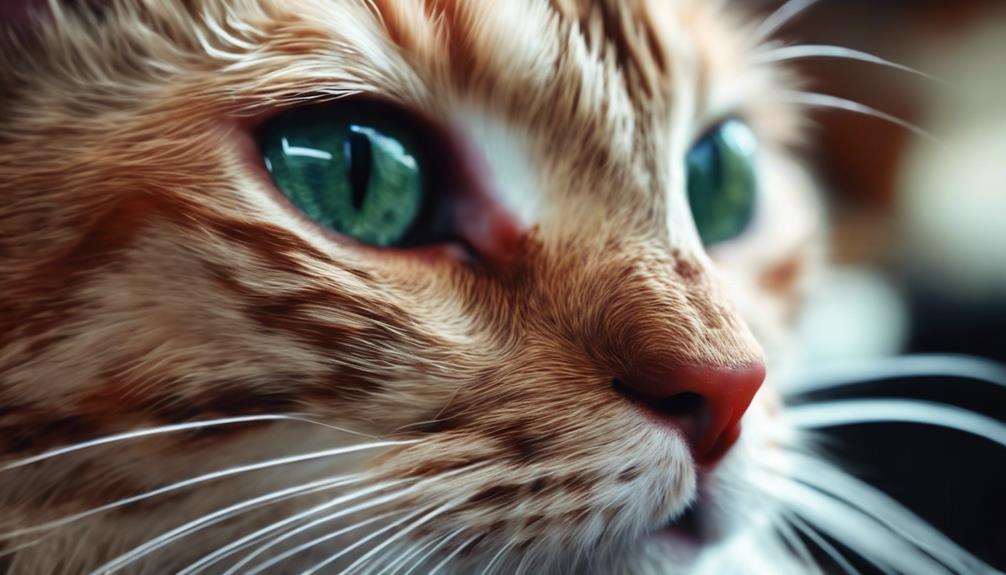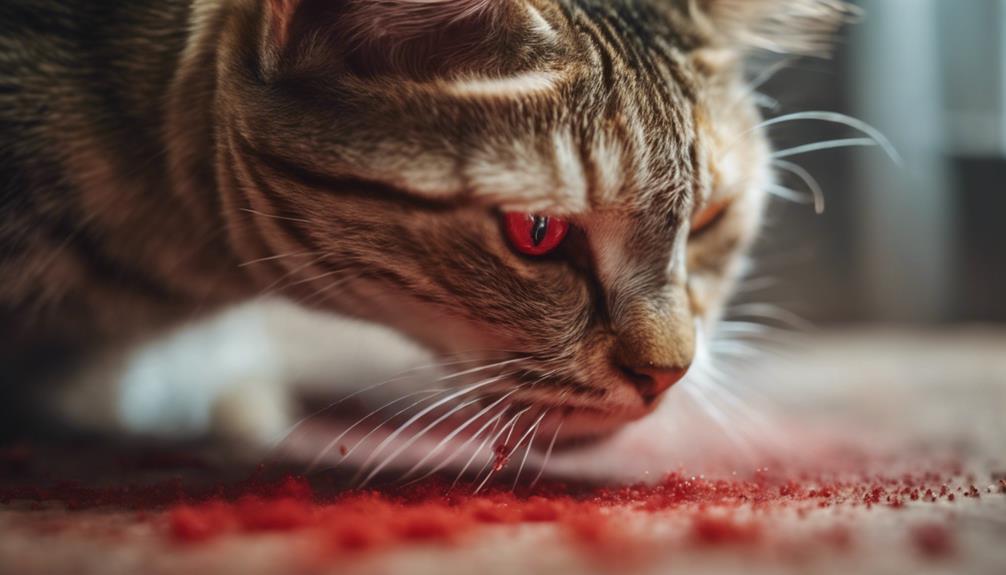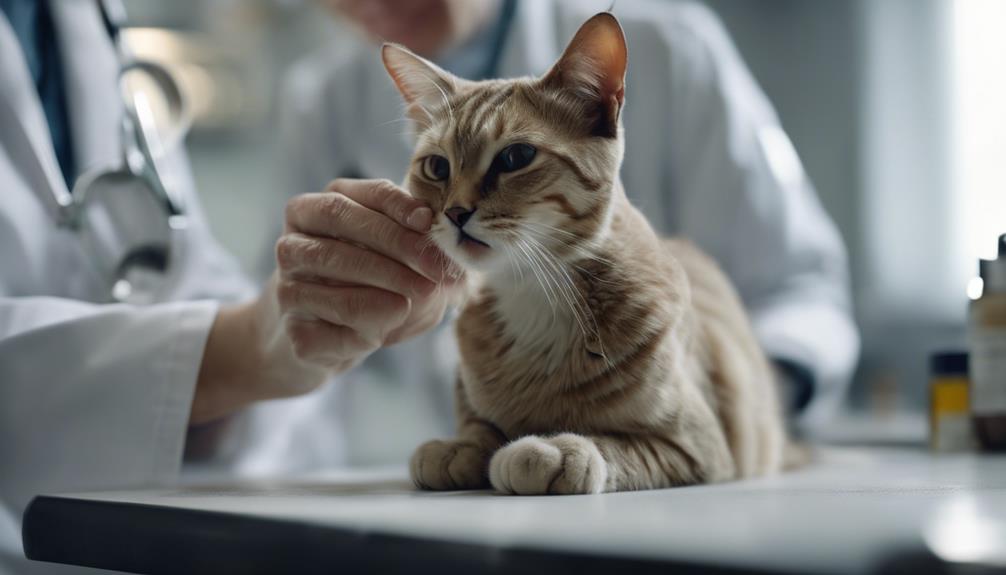Feline miliary dermatitis presents a complex interplay of factors that can challenge both pet owners and veterinary professionals. From the subtle signs of discomfort exhibited by cats to the intricate web of potential triggers, understanding this dermatological condition is crucial for effective management.
As we explore the causes, symptoms, and treatment modalities associated with miliary dermatitis in cats, a deeper dive into the nuances of this ailment reveals the importance of early detection and targeted interventions.
Key Takeaways
- Feline miliary dermatitis is an allergic skin reaction triggered by various allergens.
- Symptoms include lesions, scabs, itching, and coat thinning.
- Not contagious to humans or pets, but underlying causes might be.
- Treatment varies based on the cause, ranging from antihistamines to specific medications.
Understanding Feline Miliary Dermatitis
Feline miliary dermatitis, commonly referred to as scabby cat disease, is an allergic skin reaction in cats characterized by the development of painful lesions with scabs resembling scattered millet seeds due to various allergens.
This condition can be distressing for both cats and their owners, as it often leads to discomfort and itching for the feline companion. Understanding the underlying causes of feline miliary dermatitis is crucial in managing and treating this condition effectively.
Common Causes of Miliary Dermatitis
Understanding the common causes of miliary dermatitis in cats is essential for effectively addressing the triggers that lead to this allergic skin reaction.
The primary culprit often stems from underlying allergies, with flea allergy dermatitis being a frequent instigator in feline cases. Environmental allergens, food sensitivities, and skin parasites like mites can also provoke this condition. Additionally, drug reactions, infections, and autoimmune diseases are potential triggers for miliary dermatitis.
Identifying the root cause through thorough evaluation and diagnostic procedures is crucial in devising an appropriate treatment plan to alleviate the discomfort experienced by affected cats. By pinpointing and managing these underlying causes, veterinarians can help improve the quality of life for felines suffering from miliary dermatitis.
Recognizing Symptoms in Cats

Recognizing the symptoms of miliary dermatitis in cats requires keen observation and awareness of common indicators of this allergic skin reaction. Watch out for a red, crusty rash or pimple-like wounds on your feline friend's skin.
Your cat may exhibit frequent scratching behavior, leading to the formation of lesions and scabs from excessive scratching. Additionally, you might notice your cat engaging in excessive licking and over-grooming, causing thinning of the coat in specific areas.
These symptoms may vary in intensity depending on the underlying cause of the dermatitis. If you observe any of these signs, it is advisable to seek veterinary care promptly to determine the appropriate treatment plan for your cat's skin condition.
Contagion and Diagnostic Process
The contagious nature of miliary dermatitis in cats is not a concern for human, feline, or other pet companions, although potential underlying causes like fungal or bacterial infections can be transmissible. When faced with abnormal skin issues in cats, seeking a veterinarian's expertise is crucial for an accurate diagnosis.
Vets typically perform a thorough physical examination, which may include skin scrapings, blood tests, or allergy testing to pinpoint the root cause of the dermatitis. Diagnostic processes may involve ruling out other skin conditions with similar symptoms through biopsy or culture tests.
Initial Treatment Options Available

Upon identifying the underlying cause of feline miliary dermatitis, veterinarians may initiate treatment with a combination of antihistamines and essential fatty acids to alleviate symptoms and address the root issue effectively. This approach aims to reduce itching, inflammation, and skin lesions in affected cats. Additionally, specific treatment recommendations tailored to the cause of the dermatitis can further enhance the healing process. Below is a table summarizing initial treatment options available for various triggers of feline miliary dermatitis:
| Trigger | Initial Treatment Options |
|---|---|
| Flea Allergy | Monthly flea preventatives |
| Mange | Appropriate medications |
| Food Allergies | Eliminating offending proteins |
| Environmental Allergies | Steroids or immunotherapy |
| Autoimmune Diseases | Steroids or immunosuppressive drugs |
| Infections | Prescribed medications |
Flea Allergy as a Trigger
Flea allergy dermatitis is a common trigger for feline miliary dermatitis, leading to allergic skin reactions in cats. Cats with flea allergies are hypersensitive to flea saliva, causing intense itching and skin irritation. When a flea bites the cat, it deposits saliva containing allergenic proteins, triggering an immune response that results in miliary dermatitis symptoms. Affected cats may exhibit small, red, crusty lesions, experience hair loss from excessive scratching, and display signs of discomfort.
Preventing flea infestations through regular grooming, vacuuming, and using flea preventatives is crucial in managing flea allergy dermatitis. Prompt treatment with flea control products and consulting a veterinarian for tailored treatment plans can help alleviate the discomfort associated with this common trigger for miliary dermatitis in cats.
Managing Environmental Allergies

Addressing environmental allergies in cats involves identifying and minimizing exposure to common allergens present in their surroundings. Common environmental allergens include pollen, dust mites, mold, and certain cleaning products.
To manage environmental allergies in cats, it is essential to keep their living spaces clean by regularly vacuuming carpets, washing bedding in hot water, and using air purifiers. Additionally, reducing the cat's exposure to outdoor allergens by keeping them indoors during high pollen seasons can help alleviate symptoms.
In severe cases, your veterinarian may recommend allergy testing to pinpoint specific triggers and discuss treatment options such as antihistamines, steroids, or immunotherapy. By taking proactive steps to manage environmental allergies, you can help your cat lead a more comfortable and symptom-free life.
Addressing Food Allergies in Cats
To effectively manage potential allergic reactions in cats, including environmental allergies, it is crucial to also address the possibility of food allergies as a contributing factor to their skin issues. Food allergies in cats can manifest as itching, skin inflammation, and other dermatological problems, exacerbating miliary dermatitis. Common food allergens for cats include proteins like beef, dairy, and fish.
Identifying and eliminating these allergens from the cat's diet is a key step in managing food allergies. A veterinarian may recommend a hypoallergenic diet trial or an elimination diet to pinpoint the specific allergen. Proper diagnosis and management of food allergies can significantly improve the cat's skin condition and overall well-being, providing relief from discomfort and promoting healthier skin.
Treatment for Autoimmune Diseases

Managing autoimmune diseases in cats involves implementing targeted treatment strategies to alleviate symptoms and regulate the immune response effectively.
- Immunosuppressive Medications: These drugs help to dampen the overactive immune response that characterizes autoimmune diseases in cats. Common options include corticosteroids and other immunosuppressants.
- Immunomodulatory Therapies: These treatments aim to modulate the immune system, restoring balance and preventing further damage. Examples include cyclosporine and other immunomodulators.
- Dietary Management: Certain diets can help manage autoimmune conditions in cats by reducing inflammation and supporting overall health. Consult with a veterinarian to determine the most suitable diet for your cat's specific condition.
- Regular Monitoring: Close monitoring of your cat's condition is crucial to adjust treatment plans as needed and ensure optimal management of the autoimmune disease. Regular check-ups and communication with your veterinarian are essential for your cat's well-being.
Frequently Asked Questions
Can Feline Miliary Dermatitis Be Prevented, or Are There Any Ways to Reduce the Likelihood of a Cat Developing This Condition?
Prevention strategies for feline miliary dermatitis involve identifying and managing underlying causes like flea allergies, environmental triggers, and skin parasites. Regular veterinary check-ups, flea control, and addressing allergies promptly can help reduce the likelihood of a cat developing this condition.
Are There Any Home Remedies or Natural Treatments That Can Help Alleviate the Symptoms of Miliary Dermatitis in Cats?
While holistic approaches like oatmeal baths or coconut oil may offer temporary relief, home remedies for feline miliary dermatitis lack scientific backing. Consult a veterinarian for accurate diagnosis and tailored treatment plans to address this condition effectively.
How Long Does It Typically Take for a Cat to Show Improvement After Starting Treatment for Miliary Dermatitis?
Improvement in cats with miliary dermatitis post-treatment varies based on the underlying cause. Response times can range from a few days to several weeks. Regular monitoring by a veterinarian ensures appropriate adjustments in treatment for optimal results.
Are There Any Long-Term Effects or Complications Associated With Untreated or Poorly Managed Miliary Dermatitis in Cats?
Untreated or poorly managed feline miliary dermatitis can lead to chronic discomfort, skin infections, hair loss, and even secondary issues from excessive scratching. Long-term complications may include self-inflicted wounds, chronic skin inflammation, and reduced quality of life for affected cats.
Can Stress or Anxiety in Cats Exacerbate the Symptoms of Miliary Dermatitis, and if So, What Can Be Done to Help Reduce These Factors?
Stress or anxiety in cats can exacerbate miliary dermatitis symptoms. Addressing these factors is crucial. Techniques like creating a calming environment, providing enrichment, and using pheromone products may help reduce stress, improving the overall well-being of cats with this condition.
Conclusion
In conclusion, feline miliary dermatitis is a dermatological condition in cats characterized by allergic skin reactions. Various causes, including flea allergy, environmental triggers, and food sensitivities, can lead to the development of painful lesions and scabs on the skin.
Recognizing the symptoms and seeking proper veterinary diagnosis and treatment are essential for managing this condition effectively. Tailored treatment plans may include antihistamines, essential fatty acids, and targeted therapies based on the specific cause of the dermatitis.




